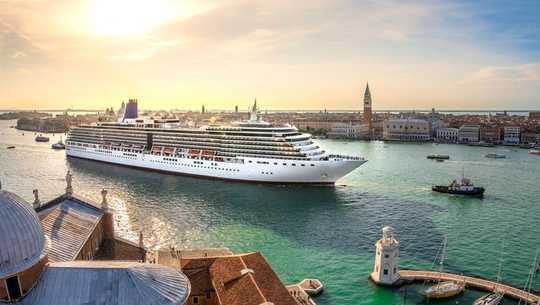
Greta Thunberg aboard the Malizia II. Greta Thunberg Media Handout/EPA
I have travelled from Plymouth to the UN headquarters in New York many times, often to discuss how to protect the oceans from climate change. The deeply uncomfortable irony was that the carbon emitted on my fossil fuel-powered journey directly contributed to the problem I was there to solve.
Greta Thunberg’s decision to travel the exact same journey to the UN Climate Action Summit on state-of-the-art sailing boat Malizia II shows that there are principled alternatives. But is there a way for the rest of us to cross the Atlantic without taking to the skies?
Thunberg’s 14-day voyage was significantly faster than the typical sail time of three to four weeks, but that’s still not for anyone in a rush. Speed comes at the cost of comfort, too. Pictures from inside Malizia II show a pared-down interior, even lacking a functional toilet on board. Such extreme measures are unlikely to interest most travellers and, at any rate, hopping on one of the world’s fastest wind-powered yachts isn’t an option for most of us.
But sailing is a more feasible option than you might think. Private boats cross the ocean constantly. New online services that match boat owners with travellers mean that hitching a ride is more plausible than ever. For those with the right skills, this could be as a member of the boat’s crew or for those without, as a passenger. Some boats require payment, others don’t.
Malizia 2 is fitted with solar panels and hydro generators making it one of the very few ships in the world allowing trips like this to be emission free.
— Greta Thunberg (@GretaThunberg) August 22, 2019
Malizia 2 also has an onboard lab to measure ocean surface CO2 and water temperature in cooperation with Max Planck institute. pic.twitter.com/XKCDgaRYZt
The market is changing, too. Companies such as UK-based VoyageVert are actively exploring opportunities to develop sail-powered oceanic travel for groups of up to 200 people and envisage a fleet of transoceanic sail-powered passenger vessels. Travelling in such a way would drastically cut the carbon cost of crossing the Atlantic – though it’s not likely to be cheap. For climate-conscious travelers with time – and probably money – to spare, sailing is the only way to travel.
A transatlantic ferry service?
But what about travel for the masses? A potentially quicker and more cost-effective alternative would be to take a ferry. Many countries are connected by ferries, but a transatlantic ferry service does not yet exist – largely because of plentiful, faster and cheaper flights. The closest alternative is to take a seven-day voyage in a cruise ship, which would set you back around £1,700 for a basic cabin and a return ticket.
This isn’t exactly cheap either – and nor will it save much on your carbon footprint. Cruise vessels are one of the most energy-intensive of all tourism activities, emitting significant quantities of greenhouse gases and health-damaging pollutants including nitrous oxide, sulphur dioxide and particulate matter. In fact, perhaps unexpectedly, the carbon dioxide generated per passenger in a standard class cabin on a seven-day cruise on board a large modern vessel is approximately 1.5 times that of a single economy flight between London and New York.
Admittedly, some of these emissions will be from the many activities on the ship rather than fuel and basic power consumption. An alternative ferry service with many of the luxuries of the cruise ship experience stripped away would be more climate-friendly, though by how much is difficult to say as ferry companies don’t routinely disclose carbon emissions. And the isolation of a seven-day oceanic journey with few activities may not appeal to many travellers.

A little too heavy for a hydrofoil. auphoto/Shutterstock
But the carbon cost of these journeys should come down significantly in the next 20 years. The traditional reliance of vessels on heavy fuel oil, which creates air pollution and contributes to climate heating, is reducing. Thanks to new International Maritime Organisation (IMO) regulations to substantially reduce air pollutant and greenhouse gas emissions from ships in the next decade, greener fuels are slowly coming into use.
Like cars, hybrid vessels combining conventional engines with batteries are also becoming increasingly common. Cruise companies are considering even greater use of battery power in response to the new 2020 regulations, as well as to minimise pollution in the sensitive environments many of their boats disturb, such as coral reefs and fjords.
Other technologies such as solar collectors, conventional sails and keel-mounted turbines are also increasingly contributing to the propulsion, electricity and heating of ships. My estimate is that collectively, these technologies could reduce carbon emissions by as much as 50% over the next 20 years.
But while these innovations will reduce both carbon emissions and damaging air pollution from vessels, if anything they’re likely to increase travel time. As such, transatlantic surface travel is likely to remain of limited appeal, even if prices become more affordable.
Hydrofoil technology that lifts a vessel’s hull out of water – thereby reducing drag and increasing speed – does have the potential to significantly reduce journey times. But for this to affect transatlantic crossings, the size and weight of ocean-going vessels would need to tumble, which means using much lighter materials that either don’t yet exist or are cost-prohibitive.
Until then, journey time will remain the primary barrier to low-carbon ocean travel. For now, the only answer for most of us wanting to minimise our impact on the planet is to minimise how much we travel across it – especially when it comes to crossing vast expanses of water.
About The Author
Steve Fletcher, Professor of Ocean Policy and Economy, University of Portsmouth
This article is republished from The Conversation under a Creative Commons license. Read the original article.
Related Books
Drawdown: The Most Comprehensive Plan Ever Proposed to Reverse Global Warming
by Paul Hawken and Tom Steyer In the face of widespread fear and apathy, an international coalition of researchers, professionals, and scientists have come together to offer a set of realistic and bold solutions to climate change. One hundred techniques and practices are described here—some are well known; some you may have never heard of. They range from clean energy to educating girls in lower-income countries to land use practices that pull carbon out of the air. The solutions exist, are economically viable, and communities throughout the world are currently enacting them with skill and determination. Available On Amazon
In the face of widespread fear and apathy, an international coalition of researchers, professionals, and scientists have come together to offer a set of realistic and bold solutions to climate change. One hundred techniques and practices are described here—some are well known; some you may have never heard of. They range from clean energy to educating girls in lower-income countries to land use practices that pull carbon out of the air. The solutions exist, are economically viable, and communities throughout the world are currently enacting them with skill and determination. Available On Amazon
Designing Climate Solutions: A Policy Guide for Low-Carbon Energy
by Hal Harvey, Robbie Orvis, Jeffrey Rissman With the effects of climate change already upon us, the need to cut global greenhouse gas emissions is nothing less than urgent. It’s a daunting challenge, but the technologies and strategies to meet it exist today. A small set of energy policies, designed and implemented well, can put us on the path to a low carbon future. Energy systems are large and complex, so energy policy must be focused and cost-effective. One-size-fits-all approaches simply won’t get the job done. Policymakers need a clear, comprehensive resource that outlines the energy policies that will have the biggest impact on our climate future, and describes how to design these policies well. Available On Amazon
With the effects of climate change already upon us, the need to cut global greenhouse gas emissions is nothing less than urgent. It’s a daunting challenge, but the technologies and strategies to meet it exist today. A small set of energy policies, designed and implemented well, can put us on the path to a low carbon future. Energy systems are large and complex, so energy policy must be focused and cost-effective. One-size-fits-all approaches simply won’t get the job done. Policymakers need a clear, comprehensive resource that outlines the energy policies that will have the biggest impact on our climate future, and describes how to design these policies well. Available On Amazon
This Changes Everything: Capitalism vs. The Climate
by Naomi Klein In This Changes Everything Naomi Klein argues that climate change isn’t just another issue to be neatly filed between taxes and health care. It’s an alarm that calls us to fix an economic system that is already failing us in many ways. Klein meticulously builds the case for how massively reducing our greenhouse emissions is our best chance to simultaneously reduce gaping inequalities, re-imagine our broken democracies, and rebuild our gutted local economies. She exposes the ideological desperation of the climate-change deniers, the messianic delusions of the would-be geoengineers, and the tragic defeatism of too many mainstream green initiatives. And she demonstrates precisely why the market has not—and cannot—fix the climate crisis but will instead make things worse, with ever more extreme and ecologically damaging extraction methods, accompanied by rampant disaster capitalism. Available On Amazon
In This Changes Everything Naomi Klein argues that climate change isn’t just another issue to be neatly filed between taxes and health care. It’s an alarm that calls us to fix an economic system that is already failing us in many ways. Klein meticulously builds the case for how massively reducing our greenhouse emissions is our best chance to simultaneously reduce gaping inequalities, re-imagine our broken democracies, and rebuild our gutted local economies. She exposes the ideological desperation of the climate-change deniers, the messianic delusions of the would-be geoengineers, and the tragic defeatism of too many mainstream green initiatives. And she demonstrates precisely why the market has not—and cannot—fix the climate crisis but will instead make things worse, with ever more extreme and ecologically damaging extraction methods, accompanied by rampant disaster capitalism. Available On Amazon
From The Publisher:
Purchases on Amazon go to defray the cost of bringing you InnerSelf.comelf.com, MightyNatural.com, and ClimateImpactNews.com at no cost and without advertisers that track your browsing habits. Even if you click on a link but don't buy these selected products, anything else you buy in that same visit on Amazon pays us a small commission. There is no additional cost to you, so please contribute to the effort. You can also use this link to use to Amazon at any time so you can help support our efforts.






















